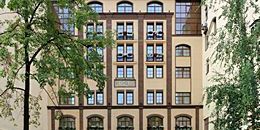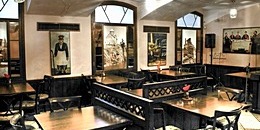Church of the Smolensk Icon of the Mother of God
In the grounds of the Smolensk Cemetery on Vasilevsky Island, this charming baroque church dates back to the mid 18th century, and is closely connected to St. Ksenia of St. Petersburg, the city's favourite saint - legend even has it that this 18th century "Holy Fool" secretly helped the builders of the stone church by carrying bricks to the site under the cover of night. As well as the separate stone chapel built in the cemetery near her grave, there is also a chapel within the church itself devoted to her. The stone church, which replaced a wooden church consecrated in 1760, was completed in 1776 to a design by Aleksei Ivanov, Professor of Architecture at the Academy of Arts.
Additions were made to the church in 1809, when architect Andrian Zakharov added the northern chapel, and again in the mid-19th century, when the Chapel of John the Baptist, with it unusually beautiful iconostasis in the Byzantine style was added. The church suffered little in the Soviet period, and was closed for only six years, between 1940 and 1947. In fact, the church benefited from the widespread closure of Petersburg churches, gaining a number of valuable holy relics, including the famous Icon of the Merciful Mother of God, a gift from the monks of Mount Athos in the 19th century.
The icon after which the church is named is one of the most celebrated in Russian history. Purported to be the work of Luke the Apostle, it originally came to Rus in 1046, when Anna, daughter of the Emperor Constantine, married Vsevolod Yaroslavich, Grand Prince of Chernogov. Moved to Smolensk, it became associated with the defense of the city against the Blue Horde of Batu Khan, and was moved to Moscow in 1812 to lend its powers to the struggle against Napoleon's forces. Returned to Smolensk, it proved less effective in the Second World War, when it vanished during the Nazi invasion. In 2005, it cropped up in a private London gallery, and negotiations are underway to have the icon returned to Russia. A copy was brought to St. Petersburg by the gangs of forced labour from Smolensk who became the first occupants of the Smolensk Cemetery in 1738.
Address: 24, Kamskaya Ulitsa
Metro station: Primorskaya
From the metro: Take buses 41 or 47, or trolleybus 9. (10 minutes)
Opening hours: Daily from 6am to 5pm.
For those who have plenty of time to explore St. Petersburg, the Church of the Smolensk Icon of the Mother of God, and the surrounding cemetery, are something of a hidden gem, well off the regular tourist track, although very popular among devout natives, who come to kiss the walls of the Chapel to Ksenia of Petersburg and lay flowers on the graves of the cemetery's most famous occupants. It's a tranquil and beautifully kept corner of the city, an ideal place for quiet contemplation. Restoration of the church itself is ongoing, but the church remains fully functional, with daily services.







